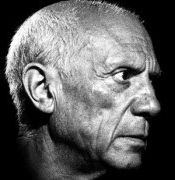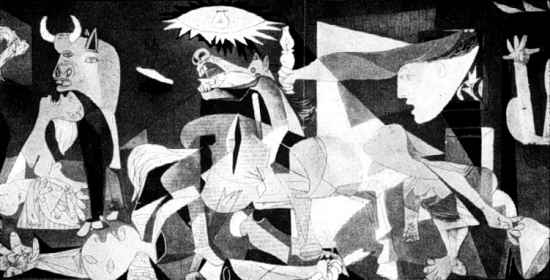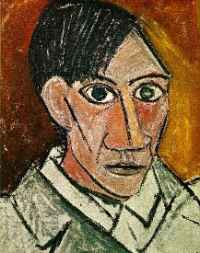Pablo Ruiz Picasso
1881 - 1973 (Málaga, España)

Top painters
Salvador Dalí
Francisco Goya
Frida Kahlo
Diego Rivera
Picasso was born in Malaga on 25th October, 1881. His parents were Maria Picasso Lopez and professor of arts Jose Ruiz Blasco. Till 1898 he was always using both last names to sign his works, but around 1901 he skipped his first last name and started to use only his mother's one. Picasso did his first paintings when he was only 10 years and in his 15 passed with brilliant success the entrance examinations to the School of Fine Arts in Barcelona with his great paint on linen - Science and Charity (1897, Museum Picasso, Barcelona). With this same picture he obtained the first honorary mention in the exhibition of Fine Arts.
Between 1900 and 1902 Picasso made three journeys to Paris and finally settled down there in 1904. The Bohemian atmosphere of the Parisian streets fascinated him from the first moment. In his pictures he captured people in the dance halls and in the coffees the assimilation of the post-impressionism of Paul Gauguin and the symbolism of the nabi painters. The themes of the work of Edgar Degas and Henri Marie Raymond Toulouse-Lautrec, exerted great influence on Picasso's own creation. The picture Blue Room (1901, Collection Phillips, Washington) reflects the work of both painters and, simultaneously, shows his evolution towards the blue period, thus called by the predominance of the blue tones in the works that Picasso made during these years. In these pictures he reflected the human misery with debilitated workers, beggars, alcoholics and prostitutes.
Picasso met his first companion, Fernande Olivier shortly after settling down in Paris in a cranky building. In this happy relationship Picasso changed his colour table towards pink and red tones; years 1904 and 1905 are known as pink period. Themes were focused on the world of the circus, that Picassooften visited and created works like Acrobat Family (1905, National Gallery, Washington). In the Harlequin Picasso reflected his alter ego, feature that he also repeated in later works.
He became friend with the poet Max Jacob, with the writer Guillaume Apollinaire, with the tradesmen Ambroise Vollard and Daniel Henry Kahnweiler and with the rich American residents in France – Gertrude Stein and her brother Leo, who became his first patrons. All of them were portrayed by the painter. During his stay in Gósol, Spain, in the summer 1906, his work entered to new phase marked by the influence of the Greek, Iberian and African art. The famous portrait of Gertrude Stein (1905–1906, Metropolitan Museum of Art, New York) reveals the face in the form of mask. The key work of this period is the Young ladies of Avignon (1907, Museum of Modern Art, New York), so radical in his style that was not understood by the critics and painters of that period. Besides the traditional painting, Picasso in this work broke the space depth and the form of naked representation of the feminine, reconstructing it by lines and sharp and angular planes.

Inspired by the volumetric treatment of the pictorial forms of Paul Cézanne, Picasso and Georges Braque painted in 1908 a series of landscapes within the style that a critic described as it had been made based on the „small cubes“, bringing into life the term cubism. Between 1908 and 1911 they worked within this line of decomposition and analysis of the forms, developing together the first stage of the cubism, known as the analytical cubism. The monochrome pallet prevailed in these representations of totally fragmented motives, shown simultaneously from several sides.
Picasso's favorite themes were musical instruments, dead nature and his friends, between whom excelled the portrait of Daniel Henry Kahnweiler (1910, Art Institute, Chicago). In 1912 he made his first collage, Still Life with Chair Caning (Museum Picasso, Paris), combining paper paste and rubber piece on linen painted only in some zones, which then represents a vase, the newspapers, a pipe, an oyster and a lemon. This technique showed the transition towards the synthetic cubism. This second phase of the cubism is more decorative, and the color plays more predominant and important role, although never in the exclusive way. Two works of 1915 demonstrate the simultaneity of styles that he used: Harlequin (Museum of Modern Art) as a synthetic cubist picture, whereas drawing of Vollard (Metropolitan Museum of Art), is made in style known as ingrist, thus denominated because it emulates the artistic forms of the French painter Jean August Dominique Ingres. The Harlequin with mirror (Museum Thyssen-Bornemisza of Madrid) was painted in 1923. It belongs to Picasso’s classic period (1921–1925), announced in the ingrist drawings as a consequence of his stay in Italy in 1917.

The bronze bust of Fernande Olivier (also call Head of woman, 1909, Museum of Modern Art) shows the completed technical ability of Picasso in the treatment of the three-dimensional forms. He also made sets – like Mandolina and clarinete (1914, Museum Picasso, Paris) – formed by fragments of wood, metal, paper and other materials, exploring with it the space hypotheses raised by the cubist painting. Its Glass of absinth (1914, Museum of Modern Art) is a colored bronze sculpture that represents an absinth glass on which appears a silver teaspoon and the exact reproduction of a lump of sugar; perhaps this is one is the most interesting example of a cubist polychromic sculpture made by Picasso, anticipating with this both his later creations of found objects like the Mandril (1951, Museum of Modern Art)and the Pop art objects of the sixties.
During the I World war, Picasso traveled to Rome to make the scenery of Russian ballets of Sergei Diáguilev. He met there the dancer Olga Koklova and married her shortly after. Within a realistic, figurative style, Picasso portrayed her in several occasions around 1917, as well as his only legitimate son, Pablo (for example in Pablo dressed like Harlequin, 1924, Museum Picasso, Paris) and his numerous friends. At the beginning of the twenties he made a series of paintings with robust, heavy, sculpturesque figures like for example Three women in the fountain (1921, Museum of Modern Art) and works inspired by mythology like Pan flutes (1923, Museum Picasso, Paris). At the same time he created also strange pictures of inflated and shapeless swimmers, with very small heads and big bodies, as well as pictures of women in violent, convulsive attitudes, indicating often with them his own vital tensions. Although Picasso always declared that he was not surrealist, in many of his pictures can be appreciated the qualities and own characteristics of this artistic movement, like in the Woman sleeping in a armchair (1927, Deprived Collection, Brussels) and The sitting Bather (1930, Museum of Modern Art). In several cubist paintings of the beginnings of the thirties predominates the harmony of lines, the curvilinear outline and a certain underlying eroticism. They reflect the the pleasure and the passion of Picasso by his new love, Marie Thérese Walter. With her he had daughter Mayan in 1935. Thérese was portrayed quite often in rest attitudes. She was also the model of the famous picture Woman in front of the mirror (1932, Museum of Modern Art). In 1935 Picasso finalized the series of engravings Minotauromaquia, a gorgeous work in which he mixes the themes of minotaur and the bullfights.

On April 26th of 1937, during the Spanish Civil War, German aviation, by order of Francisco Franco, bombed the Basque town of Guernica. Few weeks later Picasso began to paint the enormous mural known like Guernica. In less than two months Picasso finished the work. Then it was exhibited in the Spanish Pavilion of the Paris International Exhibition of 1937.
The picture does not portray the event itself; rather it expresses its violence and cruelty by means of images like the bull, the dying horse, the fallen soldier, the mother with his dead son or a woman caught in a building in flames. In spite of the complexity of these and other symbols, the Guernica obtained a great impact as picture – it denounces the horrors of the war. The outbreak and later development of Second World War caused that Picasso’s palette has darkened and that the death appeared in many of his works. For example, in Bodegón with ox skull (1942, Kunstsammlung Nordrhein-Wesfalen, Düsseldorf) and in The Charnel House (1945, Museum of Modern Art). At that time he met the painter Françoise Gilot. With her he had two children, Paloma and Claude; both appeared portrayed in numerous works. He met his last sentimental companion in 1953. It was Jacqueline Roque. Picasso portrayed her in several occasions and later married her in 1961. Since then he settled down in the south of France.
The last pictures of Picasso are based on works of the great teachers of the past like Diego Velázquez, Gustave Courbet, Eugene Delacroix and Edouard Manet. In addition to the paintings, Picasso also worked on hundreds of lithographies which were made in the press of Fernande Mourlot. He was also interested in the ceramics, and thus, in 1947 in Vallauris, he made nearly 2,000 pieces. During this time Picasso also made important sculptures: The man of the sheep (1944, Museum of Art of Filadelfia), a natural size bronze sculpture and The Goat (1950, Museum of Modern Art), also bronze one. In 1964 he finished the scale model of Woman's Head, a monumental sculpture raised in 1966 in Civic the Center de Chicago. In 1968 and throughout seven months, he created the remarkable series of 347 engravings with which he returned to his primitive themes: the circus, the bullfights of bulls, the theater and the erotic scenes.
Picasso died the 3 of April in 1973 in Notre-Dame-of-Vie, in his residence near Mougins.
Interesting links - Pablo Picasso
Pablo Picasso in Wikipedia
Picasso and Cubism
Picasso Museum in Málaga
Short biography of Pablo Picasso
Pablo Picasso Official Website
Detailed biography of Pablo Picasso
Gallery of Picasso's Paintings
The most common orthographic errors of Picassos's name are: Pablo Picaso, Pablo Pikaso and Pablo Pikasso
